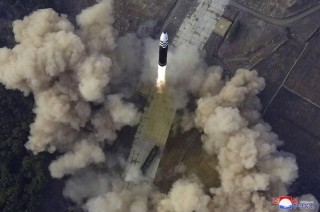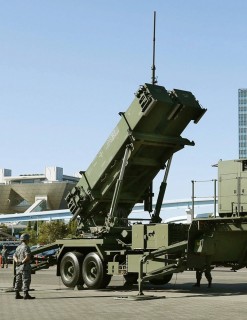Loading
Search
▼ Japan Braces For The Day It Will Be Forced To Use Missile Defense System
- Category:Other
Japan is bracing for the day when it will be forced to shoot down a North Korean rocket, following the nuclear-armed country’s launch of its “monster” new intercontinental ballistic missile last Thursday.
That ICBM, deemed capable of reaching the entire continental U.S., splashed down in Japan’s exclusive economic zone (EEZ) just 150 kilometers off the coast of Hokkaido.
That test is highly unlikely to be the last launch this year, with 2022 looking set to rival 2017, when the U.S. and North Korea teetered on the brink of nuclear conflict, according to some observers.
Indeed, North Korean leader Kim Jong Un on Monday vowed to continue developing “formidable striking capabilities” as Pyongyang seeks to “perfect the country’s nuclear war deterrent at an accelerating pace,” according to state media.
Assuming that North Korea continues to escalate its provocations — as Kim appeared to pledge, potentially putting Japanese territory under threat — the Self-Defense Forces may have to actually use Japan’s missile defense system for the first time.
Such a response would be legal under Japan’s national security laws, which also allow the country to intercept a missile flying toward the U.S. mainland by exercising the right to collective self-defense.
“The line of what the United States does not accept has been crossed. The situation has changed,” a senior Defense Ministry official said after Thursday’s ICBM launch.
That missile flew higher and for a longer duration than any of the missiles previously tested by North Korea. Fired in a lofted trajectory, or almost straight up, it traveled roughly 1,100 km for about 70 minutes, hitting an altitude of around 6,000 km — making it more powerful than the North’s Hwasong-15 ICBM, which was last tested in November 2017.
The missile, which fell closest to the Japanese archipelago out of all North Korean missiles fired so far, could have traveled an estimated 15,000 km had it been launched using a normal trajectory.
That ICBM, deemed capable of reaching the entire continental U.S., splashed down in Japan’s exclusive economic zone (EEZ) just 150 kilometers off the coast of Hokkaido.
That test is highly unlikely to be the last launch this year, with 2022 looking set to rival 2017, when the U.S. and North Korea teetered on the brink of nuclear conflict, according to some observers.
Indeed, North Korean leader Kim Jong Un on Monday vowed to continue developing “formidable striking capabilities” as Pyongyang seeks to “perfect the country’s nuclear war deterrent at an accelerating pace,” according to state media.
Assuming that North Korea continues to escalate its provocations — as Kim appeared to pledge, potentially putting Japanese territory under threat — the Self-Defense Forces may have to actually use Japan’s missile defense system for the first time.
Such a response would be legal under Japan’s national security laws, which also allow the country to intercept a missile flying toward the U.S. mainland by exercising the right to collective self-defense.
“The line of what the United States does not accept has been crossed. The situation has changed,” a senior Defense Ministry official said after Thursday’s ICBM launch.
That missile flew higher and for a longer duration than any of the missiles previously tested by North Korea. Fired in a lofted trajectory, or almost straight up, it traveled roughly 1,100 km for about 70 minutes, hitting an altitude of around 6,000 km — making it more powerful than the North’s Hwasong-15 ICBM, which was last tested in November 2017.
The missile, which fell closest to the Japanese archipelago out of all North Korean missiles fired so far, could have traveled an estimated 15,000 km had it been launched using a normal trajectory.
Currently, when the U.S. military detects a missile launch by satellite, the Japanese Defense Ministry will receive early warning information, including the number of missiles, the direction they are heading and the time and place they are expected to fall.
If a missile is expected to fall into Japanese territorial waters — as opposed to the EEZ — or strike somewhere on land, an Aegis destroyer at sea would fire missiles to shoot it down. If the attempt fails, ground-based Patriot Advanced Capability-3 missile interceptors would be used.
There are two legal arguments for allowing the interception of a missile that could fall into Japanese territory.
One is the exercise of the right to self-defense in response to an armed attack, while the other is a situation in which the defense minister issues an order to destroy a ballistic missile or other object, such as a claimed satellite, that could hit Japan.
Such an order could have been issued Thursday if the forecast for the ICBM was different.
The national security laws allow Japan to exercise the right to collective self-defense in a limited way under certain conditions, including when the country’s survival is threatened.
If a missile is expected to fall into Japanese territorial waters — as opposed to the EEZ — or strike somewhere on land, an Aegis destroyer at sea would fire missiles to shoot it down. If the attempt fails, ground-based Patriot Advanced Capability-3 missile interceptors would be used.
There are two legal arguments for allowing the interception of a missile that could fall into Japanese territory.
One is the exercise of the right to self-defense in response to an armed attack, while the other is a situation in which the defense minister issues an order to destroy a ballistic missile or other object, such as a claimed satellite, that could hit Japan.
Such an order could have been issued Thursday if the forecast for the ICBM was different.
The national security laws allow Japan to exercise the right to collective self-defense in a limited way under certain conditions, including when the country’s survival is threatened.
In parliamentary deliberations on the laws, the government had said that there might be cases in which Japan’s interception of a missile flying over the country on its way to U.S. territory would be justified.
Based on this interpretation, the Defense Ministry has not ruled out conducting such an operation, so long as it meets the legal requirements.
According to sources, the new Standard Missile-3 Block 2A interceptor, jointly developed by Japan and the United States, is capable of intercepting missiles at an altitude of more than 1,000 km, twice the level achieved by conventional SM-3 interceptors.
In November 2020, the United States conducted a successful ICBM interception test using the SM-3 Block 2A system.
“If the United States asks Japan to intercept a missile, we wouldn’t be able to decline,” a government source said.
The ministry plans to acquire the SM-3 Block 2A system within the year, and the equipment is expected to be mounted on Aegis destroyers at the Yokosuka base in Kanagawa Prefecture and the Sasebo base in Nagasaki Prefecture.
Based on this interpretation, the Defense Ministry has not ruled out conducting such an operation, so long as it meets the legal requirements.
According to sources, the new Standard Missile-3 Block 2A interceptor, jointly developed by Japan and the United States, is capable of intercepting missiles at an altitude of more than 1,000 km, twice the level achieved by conventional SM-3 interceptors.
In November 2020, the United States conducted a successful ICBM interception test using the SM-3 Block 2A system.
“If the United States asks Japan to intercept a missile, we wouldn’t be able to decline,” a government source said.
The ministry plans to acquire the SM-3 Block 2A system within the year, and the equipment is expected to be mounted on Aegis destroyers at the Yokosuka base in Kanagawa Prefecture and the Sasebo base in Nagasaki Prefecture.
- March 29, 2022
- Comment (0)
- Trackback(0)




